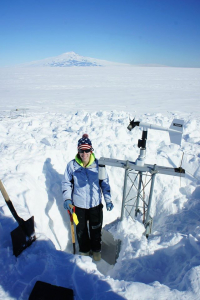Antarctic Automatic Weather Stations
What Are They Doing?
 Carol Costanza helps recover Laurie II AWS. Photo by Elin McIlhattan
Carol Costanza helps recover Laurie II AWS. Photo by Elin McIlhattan
The Antarctic Automatic Weather Station (AWS) network has been making meteorological observations since the early 1980s. This continent-wide network is positioned to observe significant meteorological events and increase our understanding of the climate of the Antarctic surface. Researchers utilize the AWS network to observe and learn about the Antarctic in a warming world. Given the duration of the AWS program and maintaining AWS sites for many years, numerous studies have been conducted on the surface climatology of regions of the continent, such as the Ross Ice Shelf. This climatology also aids in other studies, like winter warming events.
The Antarctic Automatic Weather Station network provides a greater understanding of the surface meteorology and climatology throughout the continent of Antarctica. The AWS network spans the Ross Ice Shelf, Ross Island, West Antarctica, East Antarctica, and the South Pole. Since some of the AWS have been working for over 30 years, we can begin to understand the climate over many regions of Antarctica.




 Sea ice in the the Ross Sea. Photo by Lollie Garay.
Sea ice in the the Ross Sea. Photo by Lollie Garay.
 PIPERS logo
PIPERS logo
 A DOM (Digital Optical Module) being lowered into the ice. Photo by Jim Haugen.
A DOM (Digital Optical Module) being lowered into the ice. Photo by Jim Haugen.




 Grassy tundra in Barrow, Alaska. Photo by Cristina Solis.
Grassy tundra in Barrow, Alaska. Photo by Cristina Solis.
